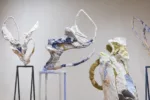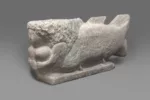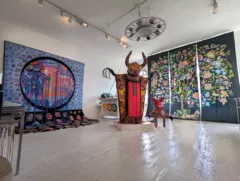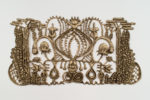Juliana Cerqueira Leite’s show “UP DOWN IN OUT” at the Trolley Gallery in London is a welcome addition to the current crop of artists who are measuring the world using themselves as the yardstick. Whether it be Marlene Dumas spreading her arms to measure the length of her grave or Antti Laitinen digging tunnels or bucking watery currents with a made to measure island or Rebecca Warren tussling with material that is too heavy for her, artists are physically wrestling with the weight of earthly and human substance.
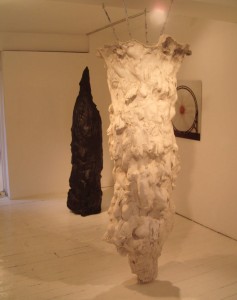
In my youth on the East Coast USA we pondered digging a hole all the way to China. How far down does an artist have to dig to make a point? Leite set up two solid blocks of clay on wooden stands 210cm x 90cm and then proceeded to dig a tunnel down into one and up into the other using only her naked body as a tool. She imposed on herself to take up the least amount of space possible. The film « Being John Malkovitch » immediately comes to mind. Someone has discovered a narrow slimy, (sewer?) tunnel that sucks a person into Malkovitch’s body. They see with his eyes. Malkovitch finds out about this portal and enters it to be sucked down into himself.
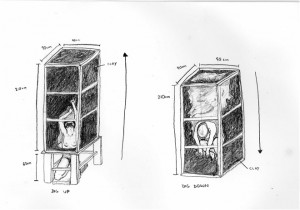
To me Leite’s forray into the clay , especially upwards, is nothing less than a trip into Uterus Bay and birth canals past, present and future. I can imagine the blocks of clay as statuesque and exuding maternity and fertility. Her trip within must have been dark, humide and oxygen deprived without the help of an umbilical cord. She doesn’t poke new eyes or nostrils into the matter like a god and accepts to be blinded by dark materials. For the voyage up these chtonian rivers that flows slow and thick no oars are required and you have to get in to get out. A seperate sculpture entitled “AROUND” completes the Diana Ross “Inside out , boy you turn me, upside down, and, all around . . .” flavor here. Leite combined “UP” and “Down” to try and go in full circle but had to stop before the clay caved in. There is a strong seaside overtone here as these are the kind of digging we naturally do at the beach. Leite is not on vacation however and it is hard to imagine a human in these spaces. These are Houdini-esque enterprises.
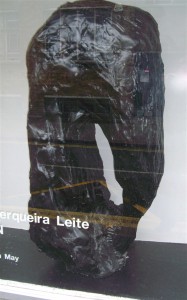
The result of these excavations come to us in the form of plaster casts. Ordinarily I find plaster a bit mortuary. Indeed here we see a kind of death mask of the action and we are forced outside of its result. I would have been much happier to climb in and have a look myself. “Down” is hung like a stalactite and recalls a vase while “UP” is a stalagmite. Together they invoke Yeat’s widening gyre in « The Second Coming” and how the winding down of one thing is always the winding up of something else. Lodging her shoulders, feet and knees against the clay walls in “Down” was the only purchase she had during the two weeks of digging. These elements poke through the stalactite’s skin and we want to grab hold of her.
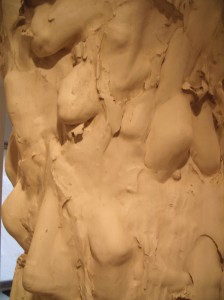
The stalagmite is smoother and easier as there was no lifting involved in the process. Her finger trails create the impression of hair. The foetal curl of “AROUND” confirms the human posture of all this digging.
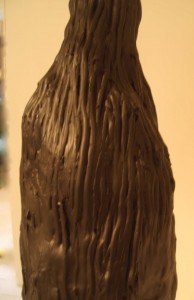
There are two photos flanking the casts which remind us that everything is turning. They depict Leite’s body in a spin, her blurred body orbiting like a cloud of electrons around its belly button nucleus ( What is the atomic number of Woman?). It feels solar and yet it casts no shadows. Clay has become skin. We know where the center of the world is, though. To there, and not to China, Leite has dug.
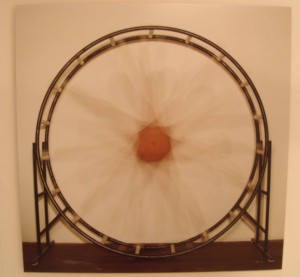
Leite continues to create and investigate dark zones of her own creation. In a series of large drawings constructed according to the theoretical paths of intersecting light we see dark zones where color is denied. These are spaces she creates with her body such as the two triangles formed when hands go on hips.
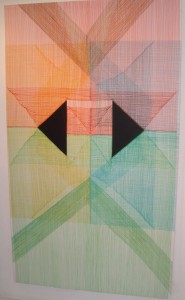
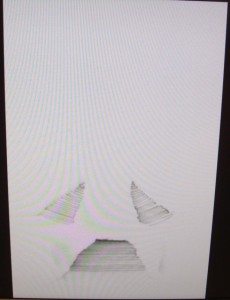
Despite all of the excavation this is a solid show. Leite and the clay are one and her actions are guided by basic geometry and the full range of human and planetary action. Dig it.


